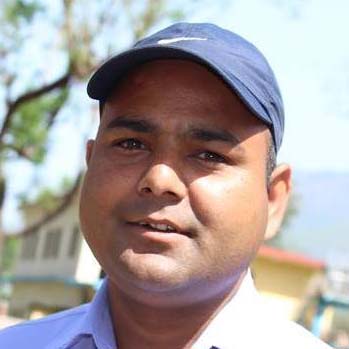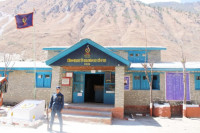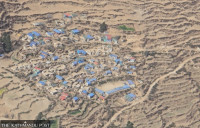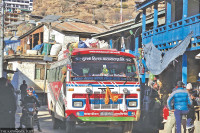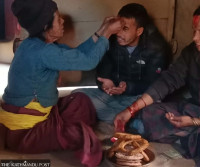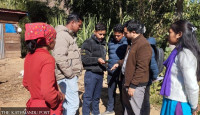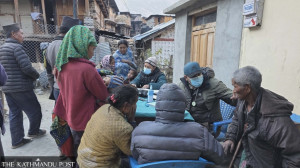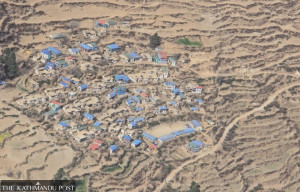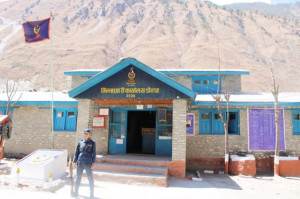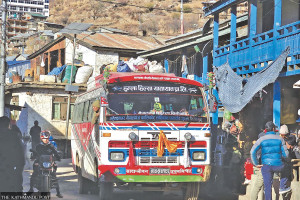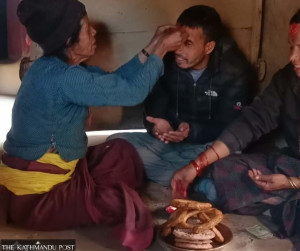Karnali Province
Yarsagumba collectors face mounting dangers and dwindling income
Climate change, falling prices, and treacherous terrain threaten the future of caterpillar fungus harvesting in Karnali.
Krishna Prasad Gautam
Nineteen-year-old Dhanlal BK had walked four days with his father to reach the mountain meadows of Nawar Pani in Nepal’s Dolpa district in the third week of May.
Like thousands of others from impoverished mountain communities, the teenager had travelled to collect yarsagumba, a prized medicinal fungus known for its aphrodisiac properties and often dubbed ‘Himalayan Viagra’.
But he never made it back.
“He got sick the very day we reached there,” his father, Hari Bahadur BK, said. “He couldn’t collect a single yarsa. We returned with some yarsagumba—but not with my son.”
The family’s home in Jajarkot had collapsed during the November 2023 earthquake, forcing them to live in a makeshift shelter. Farming barely sustained them for three months of a year.
“We went hoping it [earning from yarsa collection] would help us survive,” Hari Bahadur said. “Instead, I had to perform 13-day funeral rites for my son in a leaking shed.”
The BK family’s tragedy is not unique. On May 21, Bhim Bahadur Bohara, 34, from Jumla, also died of altitude sickness while descending from Jagadulla pasture in Dolpa. A veteran collector, he had supported his wife and three children through yarsagumba earnings for nearly a decade.
“Now there’s no breadwinner,” said his widow, Kamala Bohara. “Farming doesn’t cover our needs, and I don’t know how I’ll raise the children alone.”
On May 22, lightning killed 27-year-old Kalpana Shahi of Jumal while she was searching for yarsagumba in Subbakuna pasture.
According to Karnali Province Police, five collectors have died during this year’s harvest—three in Dolpa, one in Jumla and one in Mugu. Twenty-nine others were injured, and 13 had to be rescued for medical care.
Over the past three years, 26 collectors have lost their lives while foraging, often from high-altitude illness, hypothermia or falls.
“Treacherous terrain, unpredictable weather, and lack of preparedness put their lives at constant risk,” said Deputy Inspector General of Police Madhav Shrestha of Karnali Police.
The 2025 harvest opened in early May, but collectors returned within weeks, empty-handed and frustrated. “The yield was poor, and the market worse,” said Basanti Budha, a forest officer in Mugu. “Most didn’t even recover their travel and food expenses.”
According to the Ministry of Industry, Tourism, Forest, and Environment of Karnali Province, 309 kilogrammes of yarsagumba were harvested in the fiscal year 2022-23. Surya Sharma, information officer at the Provincial Forest Directorate, said that while 204 kilogrammes were collected last year, only around 110 kilogrammes have been harvested this year.
Minister for Industry, Tourism, Forest and Environment Suresh Adhikari of the province said that a master plan is being prepared to conserve yarsagumba as its production continues to decline.
“To strengthen the provincial economy and ensure the prosperity of Karnali, it is essential to conserve and commercialise the region’s medicinal herbs,” provincial minister Adhikari said. “Efforts are underway to promote employment generation, economic growth, and overall provincial development and prosperity through herbs and tourism.”
The drop in earnings is stark.
Purna Bahadur Devkota from Rukum West has collected yarsagumba for 15 years. This season, he and his wife spent 23 days in the pasture and returned with barely 150 pieces, earning just Rs120,000.
“In the past, we used to sell for Rs1,000 per piece but this year, traders offered only Rs800 at best,” he said. “Add the four-day trek, bitter cold, and risk of falling off cliffs, and it’s barely worth the effort. But we have no alternative.”
Dolpa’s Om Bahadur Budha, a yarsa collector since 1995, echoed that frustration. “This year, there was little rainfall, so the growth was poor. Prices were low. We risk our lives for nothing.”
Jagadulla Rural Municipality Chairperson Narasingh Rokaya said that as yarsagumba production has been declining annually, locals have not been able to earn as much as they had hoped.
“For locals who depend on traditional farming and animal husbandry, yarsagumba collection is the main source of livelihood,” he said. “But the hardship of reaching the pastures discourages the locals.”
Nearly 10,000 people collected yarsagumba in the pastures under Shey Phoksundo National Park this year. According to Nurendra Aryal, the park’s senior conservation officer, Rs19.3 million was collected this year.
The national park charged entry fees of Rs500 for buffer zone residents, Rs2,000 for locals within Dolpa, and Rs3,000 for collectors from outside the district. Access was granted through nine designated checkpoints.
Mugum-Karmarong Rural Municipality in Mugu has collected Rs3.6 million in revenue this year. According to information officer Sobendra Malla, an entry fee of Rs1,500 was charged for locals and Rs2,000 for collectors from outside the district. The Mugu Division Forest Office has issued permits for nearly 26 kilogrammes of yarsagumba this year.
The revenue set for traders is Rs31,000 per kilogramme. Forest officer Basanti Budha said only 10 traders have obtained permits so far. She added most collectors have not sold yarsagumba due to low prices.
“Until last year, yarsagumba sold for up to Rs1,000 per piece in the pastures, but this year production declined and the quality was lower, so traders refused to pay more than Rs800 per piece,” she said. “China is the main market, and for three years, Chinese traders have been lowering prices, forcing local traders to buy at the lowest rates.”
Last year, yarsagumba sold for up to Rs1.9 million per kilogramme in the district. Every year, a trade fair is held at Hajiyamar on the Mugu-China border, where local traders sell yarsagumba to Chinese buyers.
Medicinal herb trader Yagya Bahadur Budthapa said this year, yarsagumba was purchased for Rs500 to Rs800 per piece in the pastures. Due to low quality and low prices from Chinese buyers, yarsagumba was sold cheaply.
“Ninety percent of the market is China. We have to store yarsagumba in warehouses until Chinese traders arrive. Only after they set prices can we sell. Since we buy at our own risk, we cannot pay more than Rs800 per piece,” he said.
Trader Parbal Lama from Chharka Tangsong Rural Municipality in Dolpa said Chinese traders have been lowering prices further, causing problems.
Before the pandemic, yarsagumba sold for up to Rs3.2 million per kilogramme, but it barely sold for Rs2.2 million last year. He said one kilogramme contains 3,000 to 3,500 pieces of yarsagumba.
Botanist Kamal Sharma said the three-year halt in collection during the Covid-19 pandemic has affected yarsagumba reproduction.
“Production has been declining yearly, and collectors and traders also face market problems,” he said. “Factors such as irregular rainfall, increased human activity, deforestation, climate change, and wildfires have contributed to the decline in medicinal herb production.”
He said that due to a lack of arable land, poor irrigation, no alternative occupations, and no other income sources, residents of hill and mountain areas risk their lives every year collecting yarsagumba in the pastures.
XXXXXX
PHOTO:
Yarsagubma pickers and their tents in the highlands of Shey Phoksundo National Park in the Karnali province, in this recent photo:
Photo: Courtesy of Shey Phoksundo National Park




 6.1°C Kathmandu
6.1°C Kathmandu